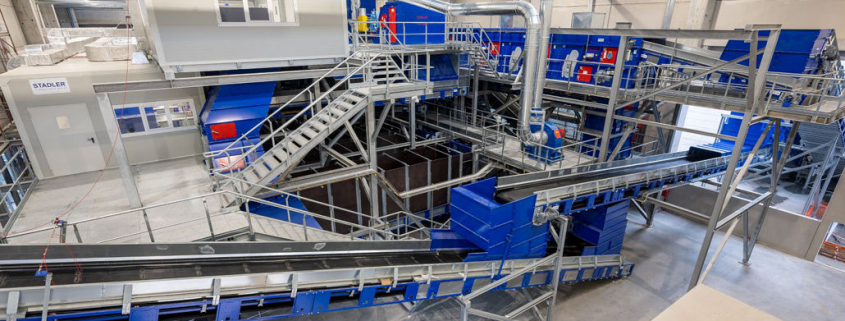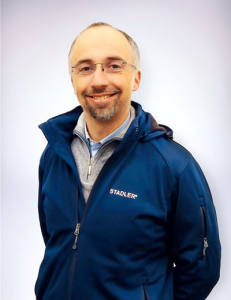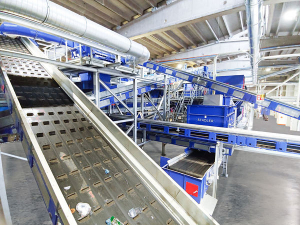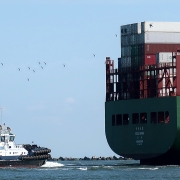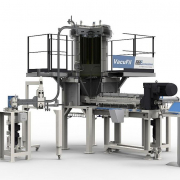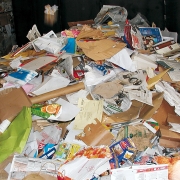Stadler Designs and Builds new GAIA and IREN Sorting Plants in Asti and Parma
As the 2030 Agenda targets loom, environmental service companies are increasingly incorporating in their business plans investments in recycling facilities capable of bringing us closer to the zero waste goal by turning it into secondary raw materials that can be returned to the commercial cycle with minimal waste.
With this aim, G.A.I.A. Spa and Iren Ambiente (which holds 45% ownership of G.A.I.A. and provides environmental services to a population of more than 3 million) called on STADLER, the German company specialized in the planning, production and assembly of turnkey recycling and sorting plants, to design and build new recycling plants in Asti and Parma.
The requirements for the two plants were different: sorting of plastic packaging from separate collection in Asti, and sorting of plastic and paper/cardboard in Parma.
STADLER’s personalized approach, capable of providing solutions even to changes requested during the construction phase, made the collaboration between the companies a success.
The new sorting plant at the Asti Waste Treatment Center
Inaugurated last October, the new plant for the sorting of plastic and metal packaging from separate waste collection plays an important role in waste management in northern Italy. The result of a 10 million euro investment, it will be able to process 50,000 tons per year of material from separate waste collection.
Flaviano Fracaro, CEO of G.A.I.A. and Technical Manager of Iren Ambiente Spa, comments: “The sorting plant is like an open-air mine, but instead of extracting raw materials from the planet, it recovers them, avoiding the dispersion of plastics in the environment or the saturation of landfills that no longer need to receive recoverable materials.”
The G.A.I.A. plant will process materials coming from the Asti basin, the Iren Group (Turin, Genoa, Piacenza, Reggio Emilia), Val d’Aosta and others who may request its services.
Once processed and cleaned, the materials coming from the separate collections will be delivered to the National Consortia for the recovery of packaging, which will transform them into secondary raw materials and reintroduce them into the production cycles.
The new plant is equipped with modern technologies in line with the Industry 4.0 objectives of the industrial plan, and the machines support the work of the manual sorting operators, resulting in a high quality product.
“We chose STADLER after an extensive technical and economical evaluation process,” comments Flaviano Fracaro. STADLER’s experience in the sector was also decisive: “STADLER was able to design plants capable of treating different types of materials with great efficiency, and in terms of the support we received, their engineers and technicians were at our side in every phase of the project.”
The plant consists of a feeding and pre-sorting section, a mechanical and optical sorting line, a sorting cabin for manual selection of the bulky products and a storage and baling line.
A drum screen performs the first selection according to size, separating the materials into three streams. The main material stream, with sizes from 50 to 350 mm, is sent to the main sorting line, consisting of:
- 10 optical separators to sort out plastic products
- 1 wind shifter system to improve the 3D – 2D separation
- 2 magnetic separators to remove ferrous metals
- 1 eddy current separator to remove non-ferrous metals
- 1 fine screen with 20 mm mesh to sift fine residue
- 1 STT5000 ballistic separator and 1 STT2000 ballistic separator to increase the quality of plastic recirculation inside the plant
- 1 bottle piercer to recover bottles even if they are filled with liquids
All the sorted plastics are stored in reversible bunkers. This material then feeds two independent pressing lines with special balers designed for plastics.
At the end of the process, the output materials are transparent PET, colored PET, light blue PET, HDPE, PP, Mixed PE+PP, LDPE+PP film, bulky plastics (4 different products), residue, fine residue, non-ferrous metals and ferrous metals.
The project presented multiple challenges, which STADLER resolved also thanks to its extensive experience in this type of plants across the world. Pietro Navarotto, Director of STADLER Italy, explains: ” In Asti we had to design a plant with many machines and conveyors in a small existing building, taking into account also the space for maintenance. We also considered the possibility of extending the line in the future. Also, since the plant sorts multiple types of materials, we had to perform many tests to check the purity of the recycled material and the recovery rates.”
The new Iren Ambiente plant in Parma
The Parma plant, soon to be completed and inaugurated, is designed to treat two different streams of material from the separate collection of paper and plastic. It is one of the most advanced plants in Italy for sorting paper and cardboard. For this plant, STADLER designed and built two highly integrated sorting lines that achieve a very high spatial efficiency by sharing the baling system.
Flaviano Fracaro comments: “We appreciated the professional approach of STADLER’s engineers and the quick response in implementing a last-minute request on the paper sorting line. We asked for the inclusion of four NIR optical sorters and STADLER was able to do this within the tight deadline.”
The plastic sorting line, which has a capacity of 9 t/h, processes PET+HDPE+PP bottles, PE+PP film, bulky plastics, mixed plastic packaging, non-ferrous and ferrous metals, while the paper sorting line, with a capacity of 20 t/h, processes cardboard, mixed paper and deinking.
The two lines have different input areas but share the same output section and baling line. Each line consists of a feed section, a section for mechanical and optical sorting, a sorting cabin for manual sorting of bulky material and a storage and baling line.
In the plastic sorting line, once the bulky waste in the pre-sorting cabin has been removed, the industrial waste can be sent to a shredder. A big drum screen performs the first selection based on the size of the material (bulky, medium and fine).
The bulky fraction is sent directly to the sorting cabin, where operators sort it into three different fractions. The main stream, of medium sized material (50 – 380 mm), is fed to an STT5000 ballistic separator which divides the products according to their ballistic and weight characteristics into fine, 3D (heavy and/or rolling objects) and 2D (flat and light objects) fractions.
All fractions then pass through the plant where the following machines are located:
- 3 optical separators to sort the different types of plastics
- 1 wind shifter system to improve 2D – 3D separation
- 1 magnetic separator to remove ferrous metals
- 1 eddy current separator for the removal of non-ferrous metals
A movable conveyor under the first NIR optical unit of the paper line ensures great flexibility in the sorting process, while the second optical separator can work with either the positive or negative selection from the first NIR unit, optimizing paper recovery.
The paper sorting line starts with a PPK2000_6_3H ballistic separator which is specially designed to separate bulkier cardboard from lighter paper. The cardboard is sent directly to the picking cabin while the main stream (< 300 mm) is sent to two parallel sorting lines. Each line consists of a PPK2000_6_1 ballistic separator that removes fine fractions (< 50 mm) and two 2800 mm NIR optical sorters that separate mixed and deinking paper from the main stream. The sorted material is then sent to the picking cabin for manual sorting.
Pietro Navarotto explains: “In addition to the change requested by the customer during the project’s implementation, the other difficulty was installing the paper line once the plastic line was in place. It is at times like these that the great experience of our engineers and installers makes the difference and guarantees the professionalism we are known for.”
“So far, the performance of the two plants in Parma and Asti has lived up to our expectations,” said Flaviano Fracaro. We hope that in the future they will even exceed them!”
Source: STADLER (Altshausen, Germany, 8 December, 2021)

